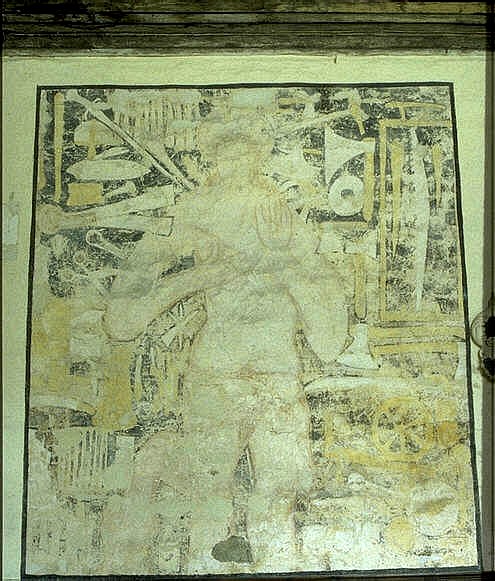Michaelchurch Escley, Herefordshire (†Hereford) C.15
Warning to Sabbath Breakers

This large and very striking painting is the only one now left in this Welsh border church. It seems to me as certain as anything can be that this is a Warning to Sabbath Breakers and not the ‘Consecration of Labour’ alias ‘Christ of the Trades/As Piers Plowman’ (my scepticism about whether this subject ever existed in England deepens)¹ discussed in the Introduction.
The inclusion of a sword touching Christ’s shoulder in the top left hand corner defines the relationship of these agricultural and domestic implements to him – they have become weapons. Shears and scissors cut into his arm on the left, a small axe placed vertically and surrounded by others of various sizes does the same on the right. All the various implement menace him, in fact. Clinching the identification, I think, are the three nails, or two nails and a wedge of the type sometimes seen stabilising the foot of the Cross, painted just below Christ’s forearm. These are at once everyday nails and Instruments of the Passion, symbolically arranged as such. This is the Warning to Sabbath-Breakers borrowing from the Image of Pity.²
It is hard to see, but Christ’s gesture with his left hand (his right rests on the wound in his side) is odd. At first glance this looks like a blessing, but in fact, the fifth, smallest, finger is crossed over the fourth, with the other fingers and thumb simply extended. This thoroughly unnatural contortion (try it), with the left hand moreover, surely cannot be intended to bless. What, if anything, it might imply – an anti-blessing? – I have no idea, and opinions are welcome.
The implements, incidentally, are listed in the church leaflet as including wool combs, axes, saws, knives, a plane, saw, hammer, mallet, mattock, spokeshave, jug, wheel, gridiron, frying pan, awl and bobbin, but there are scythe blades too, and other items, especially at the lower edge, difficult to identify now.
(For more on the Image of Pity see also the Mass of St Gregory at Slapton.)
¹ Joan Evans, in English Art, 1307-1461 is sceptical too. She also comments on the ‘contaminatio’ from depictions of the Instruments of the Passion , English Art, Appendix A (Oxford, 1949)
² Eamon Duffy has a good example of the kind of Image of Pity I mean as plate 85 in The Stripping of the Altars (Yale, 1992). The crossed hammer, pincers and nail are suggestively similar to the Michaelchurch painting.
There is of course another cross-current here involving the Pietà on the rare occasions (e.g. at Broughton) when it occurs in the English church.
† in page heading = Diocese